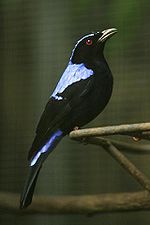(New page: The '''Tigmamanukan''' is an omen bird in Philippine mythology. [[Image:Tigmamanukan.jpg|thumb|The Asian Fairy Bluebird (Irena puella turcosa) is one of two species that have been sugges...) |
|||
| (2 intermediate revisions by 2 users not shown) | |||
| Line 1: | Line 1: | ||
The '''Tigmamanukan''' is an omen bird in Philippine mythology. | The '''Tigmamanukan''' is an omen bird in Philippine mythology. | ||
[[Image:Tigmamanukan.jpg|thumb|The Asian Fairy Bluebird (Irena puella turcosa) is one of two species that have been suggested to be the actual bird referred to by the ancient Tagalogs as the tigmamanukan.]] | |||
==Etymology== | ==Etymology== | ||
Tigmamanukan originated from a Tagalog word | Tigmamanukan originated from a Tagalog word ''manuk'' or ''manok'', which means ''chicken''. However, in Pre-colonial Philippines, it refers to any bird, lizard or snake that crossed one's path. | ||
== | |||
==Myth== | |||
According to one of the Filipino creation myth, the accountable for opening the bamboo that let out the first man and first woman was the Tigmamanukan. | According to one of the Filipino creation myth, the accountable for opening the bamboo that let out the first man and first woman was the Tigmamanukan. | ||
==Powers== | |||
According to San Buenaventura's 1613 ''Dictionary of the Tagalog Language'', one of the few primary written sources for Philippine precolonial culture, the Tagalogs believed that the direction of a tigmamanukan flying across one's path at the beginning a journey indicated whether that journey would be successful or not. | |||
If it flew from right to left, the expedition would be a success. This sign was called ''labay.'' (In some Filipino languages, ''labay'' today still means ''proceed''.) If the bird flew from left to right, the travelers would surely never return. | |||
It was also said that if a hunter caught a tigmamanukan in a trap, they would cut its beak and release it, saying ''Kita ay iwawala, kun akoy mey kakawnan, lalabay ka.'' ('You are free, so when I set forth, sing on the right.) | |||
==See also== | ==See also== | ||
*[[Sarimanok]] | *[[Sarimanok]] | ||
==References== | ==References== | ||
| Line 18: | Line 29: | ||
*Meyer, A.B.. ''The Tagals Tigmamanukan''. in Blumentritt, Ferdinand. Dictionario Mitologica de Pilipinas. pp. 34, 118 | *Meyer, A.B.. ''The Tagals Tigmamanukan''. in Blumentritt, Ferdinand. Dictionario Mitologica de Pilipinas. pp. 34, 118 | ||
*Garcia, Mauro (Ed.) (1979). ''Readings in Philippine Prehistory''. Manila 1979: Filipiniana Book Guild, Inc. | *Garcia, Mauro (Ed.) (1979). ''Readings in Philippine Prehistory''. Manila 1979: Filipiniana Book Guild, Inc. | ||
[[Category: Philippine mythology]] | |||
[[Category: Legendary birds]] | |||
Latest revision as of 20:44, 19 September 2010
The Tigmamanukan is an omen bird in Philippine mythology.
Etymology
Tigmamanukan originated from a Tagalog word manuk or manok, which means chicken. However, in Pre-colonial Philippines, it refers to any bird, lizard or snake that crossed one's path.
Myth
According to one of the Filipino creation myth, the accountable for opening the bamboo that let out the first man and first woman was the Tigmamanukan.
Powers
According to San Buenaventura's 1613 Dictionary of the Tagalog Language, one of the few primary written sources for Philippine precolonial culture, the Tagalogs believed that the direction of a tigmamanukan flying across one's path at the beginning a journey indicated whether that journey would be successful or not.
If it flew from right to left, the expedition would be a success. This sign was called labay. (In some Filipino languages, labay today still means proceed.) If the bird flew from left to right, the travelers would surely never return.
It was also said that if a hunter caught a tigmamanukan in a trap, they would cut its beak and release it, saying Kita ay iwawala, kun akoy mey kakawnan, lalabay ka. ('You are free, so when I set forth, sing on the right.)
See also
References
- Scott, William Henry (1994). Barangay: Sixteenth Century Philippine Culture and Society. Quezon City: Ateneo de Manila University Press. ISBN 971-550-135-4.
- Zamora, Adelaida (24 February 2005). Nagbuhat Sa Bughaw.
- Forbes, Henry (Oct., 1885). A Naturalist's Wanderings in the Eastern Archipelago. A Narrative of Travel and Exploration from 1878 to 1883. The American Naturalist
- Meyer, A.B.. The Tagals Tigmamanukan. in Blumentritt, Ferdinand. Dictionario Mitologica de Pilipinas. pp. 34, 118
- Garcia, Mauro (Ed.) (1979). Readings in Philippine Prehistory. Manila 1979: Filipiniana Book Guild, Inc.

